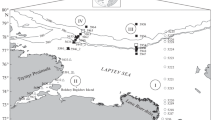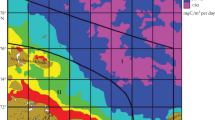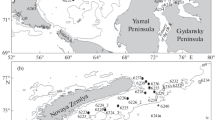Abstract
Seasonal variations in primary production (PP) in the Kara Sea are underresearched. Previous studies only collected data during autumn or in late summer. However, the middle of summer is close to the beginning of the growing season, when PP can contribute significantly to annual water column integrated primary production (IPP). In addition, differences can be expected in the spatial and vertical distribution of phytoplankton communities in this period. This gap in midsummer data was addressed within the framework of a multidisciplinary research cruise by the R/V “Akademik Mstislav Keldysh” (from 15 July to 18 August 2016). High values of IPP (> 200 mgC m−2 day−1) and surface chlorophyll a (Chl a) concentration (Chl0 > 1 mg m−3) were associated with the Ob–Yenisey river plume, located in the central part of the Kara Sea. Beyond the influence of the plume, in the western and southwestern regions of the Kara Sea, well-pronounced subsurface chlorophyll maxima (SCM) were observed. In some cases, the Chl a concentration in SCM exceeded Chl0 by two orders of magnitude. SCM were often accompanied by subsurface PP maxima (SPM). At stations where SCM was pronounced, IPP values reached 500–800 mgC m−2 day−1, and > 30 % of IPP was accounted for by SPM-integrated PP. Thus, in the middle of summer in the Kara Sea, IPP was linked with the chlorophyll-specific phytoplankton biomass and depended on the strength of the SCM.









Similar content being viewed by others
References
Amon RMW (2004) The role of dissolved organic matter for the organic carbon cycle in the Arctic Ocean. In: Stein R, Macdonald RW (eds) The organic carbon cycle in the Arctic Ocean. Springer, Berlin, pp 83–100
Anonymous (1958) The Venice System for the classification of marine waters according to salinity. Limnol Oceanogr 3:346–347
Ardyna M, Gosselin M, Michel C, Poulin M, Tremblay JÉ (2011) Environmental forcing of phytoplankton community structure and function in the Canadian High Arctic: contrasting oligotrophic and eutrophic regions. Mar Ecol Progr Ser 442:37–57
Ardyna M, Babin M, Gosselin M, Devred E, Bélanger S, Matsuoka A, Tremblay JÉ (2013) Parameterization of vertical chlorophyll a in the Arctic Ocean: impact of the subsurface chlorophyll maximum on regional, seasonal and annual primary production estimates. Biogeosciences 10:1345–1399
Arrigo KR, van Dijken GL (2011) Secular trends in Arctic Ocean net primary production. J Geophys Res. https://doi.org/10.1029/2011JC007151
Arrigo KR, van Dijken GL (2015) Continued increases in Arctic Ocean primary production. Prog Oceanogr 136:60–70
Arrigo KR, van Dijken GL, Pabi S (2008) Impact of a shrinking Arctic ice cover on marine primary production. Geophys Res Lett. https://doi.org/10.1029/2008GL035028
Arrigo KR, Matrai PA, van Dijken GL (2011) Primary productivity in the Arctic Ocean: impact of complex optical properties and subsurface chlorophyll maxima on large-scale estimates. J Geophys Res. https://doi.org/10.1029/2011JC007273
Bélanger S, Babin M, Tremblay JÉ (2013) Increasing cloudiness in Arctic damps the increase in phytoplankton primary production due to sea ice receding. Biogeosciences 10:4087–4101
Bobrov UA, Savinov VM, Makarevich PR (1989) Chlorophyll and primary production. In: Ecology and bioresourses of the Kara Sea. Kolsky scientific center, Apatity, pp 45–50 (in Russian)
Brown ZW, Lowry KE, Palmer MA, van Dijken GL, Mills MM, Pickart RS, Arrigo KR (2015) Characterizing the subsurface chlorophyll a maximum in the Chukchi Sea and Canada Basin. Deep Sea Res II 118:88–104
Cavalieri DJ, Parkinson CL (2012) Arctic sea ice variability and trends, 1979–2010. Cryosphere 6:881–889
Cherkasheva A, Nöthig EM, Bauerfeind E, Melsheimer C, Bracher A (2013) From the chlorophyll-a in the surface layer to its vertical profile: a Greenland Sea relationship for satellite applications. Ocean Sci 9:431–445
Comiso JC (2012) The rapid decline of multiyear ice cover. J Clim. https://doi.org/10.1175/JCLI-D11-00113.1
Comiso JC, Parkinson CL, Gersten R, Stock L (2008) Accelerated decline in the Arctic sea ice cover. Geophys Res Lett. https://doi.org/10.1029/2007GL031972
Cota GF, Pomeroy LR, Harrison WG, Jones EP, Peters F, Sheldon WM Jr, Weingartner TR (1996) Nutrients, primary production and microbial heterotrophy in the southeastern Chukchi Sea: Arctic summer nutrient depletion and heterotrophy. Mar Ecol Progr Ser 135:247–258
Cullen JJ (2015) Subsurface chlorophyll maximum layers: enduring enigma or mystery solved? Annu Rev Mar Sci 7:207–239
Demidov AB, Mosharov SA (2015) Vertical distribution of primary production and chlorophyll a in the Kara Sea. Oceanology 55:521–534
Demidov AB, Mosharov SA, Makkaveev PN (2014) Patterns of the Kara Sea primary production in autumn: biotic and abiotic forcing of subsurface layer. J Mar Sys 132:130–149
Demidov AB, Kopelevich OV, Mosharov SA, Sheberstov SV, Vazyulya SV (2017a) Modelling Kara Sea phytoplankton primary production: development and skill assessment of regional algorithms. J Sea Res 125:1–17
Demidov AB, Sheberstov SV, Gagarin VI, Khlebopashev PV (2017b) Seasonal variation of the satellite-derived phytoplankton primary production in the Kara Sea. Oceanology 57:91–104
Dittmar T, Kattner G (2003) The biogeochemistry of the river and shelf system of the Arctic Ocean: a review. Mar Chem 83:103–120
Egge JK, Aksnes DL (1992) Silicate as regulating nutrient in phytoplankton competition. Mar Ecol Progr Ser 83:281–289
Fisher TR, Peele ER, Ammerman JW, Harding LWJ (1992) Nutrient limitation of phytoplankton in Chesapeake Bay. Mar Ecol Progr Ser 82:51–63
Fütterer DK, Galimov EM (2003) Siberian river run-off into the Kara Sea: characterization, quantification, variability and environmental significance - an introduction. In: Stein R, Fahl K, Fütterer DK, Galimov EM, Stepanets OV (eds) Siberian river run-off in the Kara Sea. Elsevier, Amsterdam, pp 1–8
Gordeev VV, Kravchishina MD (2009) River flux of dissolved organic carbon (DOC) and particulate organic carbon (POC) to the Arctic Ocean: what are the consequences of the global changes? In: Nihoul JCJ, Kostianoy AG (eds) Influence of climate change on the changing Arctic and Sub-Arctic conditions. Springer, Dordrecht, pp 145–160
Gordeev VV, Martin JM, Sidorov IS, Sidorova MV (1996) A reassessment of the Eurasian river input of water, sediment, major elements and nutrients to the Arctic Ocean. Am J Sci 296:664–691
Grasshoff K, Kremling K, Ehrhardt M (1999) Methods of seawater analysis, 3rd edn. Wiley, New York
Hansen HP, Koroleff F (1999) Determination of nutrients. In: Grashoff K, Kremling K, Ehrhard M (eds) Methods of seawater analysis, 3rd edn. Wiley, NewYork, pp 149–228
Hanzlick D, Aagaard K (1980) Freshwater and Atlantic water in the Kara Sea. J Geophys Res 85:4937–4942
Hill VJ, Cota GF (2005) Spatial patterns of primary production on the shelf, slope and basin of the Western Arctic in 2002. Deep Sea Res II 57:3344–3354
Hill VJ, Zimmerman RC (2010) Estimates of primary production by remote sensing in the Arctic Ocean: assessment of accuracy with passive and active sensors. Deep Sea Res I 57:1243–1254
Hill VJ, Matrai PA, Olson E, Suttles S, Steele M, Codispoti LA, Zimmerman RC (2013) Synthesis of integrated primary production in the Arctic Ocean: II. In situ and remotely sensed estimates. Prog Oceanogr 110:107–125
Holmes RM, Peterson BJ, Gordeev VV, Zhulidov AV, Meybeck M, Lammers RB, Vörösmarty CJ (2000) Flux of nutrients from Russian rivers to the Arctic Ocean: can we establish a baseline against which to judge future changes? Water Resour Res 36:2309–2320
Holmes RM, McClelland JW, Peterson BJ, Tank SE, Bulygina E, Eglinton TI, Gordeev VV, Gurtovaya TY, Raymond PA, Repeta DJ, Staples R, Striegl RG, Zhulidov AV, Zimov SA (2012) Seasonal and annual fluxes of nutrients and organic matter from large rivers to the Arctic Ocean and surrounding seas. Estuaries Coasts 35:369–382
Holm-Hansen O, Riemann B (1978) Chlorophyll a determination: improvements in methodology. Oikos 30:438–447
Holm-Hansen O, Lorenzen CJ, Holmes RW, Strickland JDH (1965) Fluorometric determination of chlorophyll. J Cons Perm Int Explor Mer 30:3–15
Kubryakov A, Stanichny S, Zatsepin A (2016) River plume dynamics in the Kara Sea from altimetry-based lagrangian model, satellite salinity and chlorophyll data. Remote Sens Environ 176:177–187
Kwok R, Cunningham GF, Wensnahan M, Rigor I, Zwally HJ, Yi D (2009) Thinning and volume loss of Arctic sea ice: 2003–2008. J Geophys Res. https://doi.org/10.1029/2009JC005312
Le Fouest V, Babin M, Tremblay JÉ (2013) The fate of riverine nutrients on Arctic shelves. Biogeosciences 10:3661–3677
Lee SH, Whitledge TE (2005) Primary and new production in the deep Canada Basin during summer 2002. Polar Biol 28:190–197
Lee YJ, Matrai PA, Friedrichs MAM, Saba VS, Antoine D, Ardyna M, Asanuma I, Babin M, Bélanger S, Benoȋt-Gagné M, Devred E, Fernández-Méndez M, Gentili B, Hirawake T, Kang Sung-Ho, Kameda T, Katlein C, Lee SH, Lee Z, Mélin F, Scardi M, Smyth TJ, Tang S, Turpie KR, Waters KJ, Westberry TK (2015) An assessment of phytoplankton primary productivity in the Arctic Ocean from satellite ocean color/in situ chlorophyll-a based models. J Geophys Res 120:6508–6541
Leu E, Søreide JE, Hessen DO, Falk-Petersen S, Berge J (2011) Consequences of changing sea-ice cover for primary and secondary producers in the European Arctic shelf seas: timing, quantity, and quality. Prog Oceanogr 90:18–32
Makkaveev PN (1998) The total alkalinity in the anoxic waters of the Black Sea and in sea-river mixture zones. In: Annex V (ed) Proceedings of 7th Session of Intergovernmental Oceanographic Commission. Joint IOC-JGOFS CO2 Advisory Panel Meeting, UNESCO
Martin J, Tremblay JÉ, Gagnon J, Tremblay G, Lapoussiére A, Jose C, Poulin M, Gosselin M, Gratton Y, Michel C (2010) Prevalence, structure and properties of subsurface chlorophyll maxima in Canadian Arctic waters. Mar Ecol Progr Ser 412:69–84
Martin J, Tremblay JÉ, Price NM (2012) Nutritive and photosynthetic ecology of subsurface chlorophyll maxima in Canadian Arctic waters. Biogeosciences 9:5353–5371
Matrai PA, Olson E, Suttles S, Hill V, Codispoti LA, Light B, Steele M (2013) Synthesis of primary production in the Arctic Ocean: I. Surface waters, 1954–2007. Prog Oceanogr 110:93–106
Millero FJ (1995) Thermodynamics of the carbon dioxide system in oceans. Geochim Cosmochim Acta 59:661–677
Mosharov SA (2010) Distribution of the primary production and chlorophyll a in the Kara Sea in September of 2007. Oceanology 50:885–893
Mosharov SA, Demidov AB, Simakova UV (2016) Peculiarities of the primary production process in the Kara Sea at the end of the vegetation season. Oceanology 56:84–94
Opsahl S, Benner R, Amon RW (1999) Major flux of terrigenous dissolved organic matter through the Arctic Ocean. Limnol Ocenogr 44:2017–2023
Pabi S, van Dijken GL, Arrigo KR (2008) Primary production in the Arctic Ocean, 1998–2006. J Geophys Res. https://doi.org/10.1029/2007/JC004578
Petrenko D, Pozdnyakov D, Johannessen J, Counillon F, Sychov V (2013) Satellite-derived multi-year trend in primary production in the Arctic Ocean. Int J Remote Sens 34:3903–3937
Pivovarov S, Schlitzer R, Novikhin A (2003) River run-off influence on the water mass formation in the Kara Sea. In: Stein R, Fahl K, Fütterer DK, Galimov EM, Stepanets OV (eds) Siberian river run-off in the Kara Sea. Elsevier, Amsterdam, pp 9–25
Rachold V, Eicken H, Gordeev VV, Grigoriev MN, Hubberten HW, Lisitzin AP, Shevchenko VP, Schirrmeister L (2004) Modern terrigenous organic carbon input to the Arctic Ocean. In: Stein R, Macdonald RW (eds) The organic carbon cycle in the Arctic Ocean. Springer-Verlag, Berlin, pp 33–56
Ryther JH, Yentsch CS (1957) The estimation of phytoplankton production in the ocean from chlorophyll and light data. Limnol Oceanogr 2:281–286
Sakshaug E (2004) Primary and secondary production in the Arctic Seas. In: Stein R, Macdonald RW (eds) The organic carbon cycle in the Arctic Ocean. Springer, Berlin, pp 57–81
Steemann Nielsen E (1952) The use of radioactive carbon (C14) for measuring organic production in the sea. J Cons Perm Int Explor Mer 18:117–140
Stein R (2000) Circum Arctic river discharge and its geological record. Int J Earth Sci 89:447–449
Stroeve J, Holland M, Meier W, Scambos T, Serreze M (2007) Arctic sea ice decline: faster than forecast. Geophys Res Lett. https://doi.org/10.1029/2007GL029703
Stroeve J, Kattsov V, Barrett A, Serreze M, Pavlova T, Holland M, Meier WN (2012a) Trends in Arctic sea ice extent from CMIP5, CMIP3 and observations. Geophys Res Lett. https://doi.org/10.1029/2012GL052676
Stroeve J, Serreze M, Holland M, Kay J, Malanik J, Barrett A (2012b) The Arctic’s rapidly shrinking sea ice cover: a research synthesis. Clim Change 110:1005–1027
Timmermans ML, Cole S, Toole J (2012) Horizontal density structure and restratification of the Arctic Ocean surface layer. J Phys Oceanogr 42:659–668
Tremblay JÉ, Gagnon J (2009) The effect of irradiance and nutrient supply on the productivity of Arctic waters: a perspective on climate change. In: Nihpul JCJ, Kostianoy AG (eds) Influence of climate change on the changing Arctic and Sub-Arctic condition. Springer, New York, pp 73–94
Tremblay JÉ, Michel C, Hobson KA (2006) Bloom dynamics in early opening waters of the Arctic Ocean. Limnol Oceanogr 51:900–912
Uitz J, Claustre H, Morel A, Hooker SB (2006) Vertical distribution of phytoplankton communities in open ocean: an assessment on surface chlorophyll. J Geophys Res 111:C08005. https://doi.org/10.1029/2005JC003207
UNESCO (1983) IOC manuals and guides 12. Chemical methods for use in marine environment monitoring
Vancoppenolle M, Bopp L, Madec G, Dunne J, Ilyina T, Halloran PR, Steiner N (2013) Future Arctic Ocean primary productivity from CMIP5 simulations: uncertain outcome, but consistent mechanisms. Glob Biogeochem Cycle. https://doi.org/10.1002/gbc.20055
Vedernikov VI, Demidov AB, Sud’bin AI (1995) Primary production and chlorophyll in the Kara Sea in September 1993. Oceanology 34:630–640
Vetrov AA, Romankevich EA (2004) Carbon cycle in the Russian Arctic seas. Springer, Berlin
Zatsepin AG, Zavialov PO, Kremenetskiy VV, Poyarkov SG, Soloviev DM (2010) The upper desalinated layer in the Kara Sea. Oceanology 50:658–668
Zatsepin AG, Zavialov PO, Baranov VI, Kremenetskiy VV, Nedospasov AA, Poyarkov SG, Ocherednik VV (2017) On the mechanism of wind-induced transformation of a river runoff water lens in the Kara Sea. Oceanology 57:1–7
Zhai L, Gudmundsson K, Miller P, Peng W, Guðfinnsson H, Debes H, Hátún H, White GN, Hernández Walls R, Sathyendranath S, Platt T (2012) Phytoplankton phenology and production around Iceland and Faroes. Cont Shelf Res 37:15–25
Zhang J, Spitz YH, Steele M, Ashjian C, Campbell R, Berline L, Matrai P (2010) Modeling the impact of declining sea ice on the Arctic marine planktonic ecosystem. J Geophys Res. https://doi.org/10.1029/2009/JC005387
Acknowledgements
We thank Paul Seward, PhD, from Edanz Group (www.edanzediting.com/ac) for editing a draft of this manuscript. We thank the crew of the R/V “Akademik Mstislav Keldysh” for their cooperation during the 66th cruise. We are grateful to the GSFC (Goddard Space Flight Center, Distributed Active Archive Center) at NASA for the MODIS-Aqua data and The Arctic Great Rivers Observatory (Arctic-GRO) project for Ob and Yenisey discharge data. Thanks are given to A. A. Kubryakov and S. S. Stanichny for calculations of river plume dynamics. This work was supported by the Russian Foundation for Fundamental Research (project no. 16-05-00050). Expeditionary observations and sample treatments were supported by the Russian Science Foundation (project no. 14-50-00095, scientific direction “Ecosystems of strategically important marine regions of Russian Federation”). The application of optic data were supported by the Russian Science Foundation (project no. 14-50-00095, scientific direction “Interaction of physical, biological and geological processes at coastal zone, shore waters and inland seas”).
Author information
Authors and Affiliations
Corresponding author
Electronic supplementary material
Below is the link to the electronic supplementary material.
Rights and permissions
About this article
Cite this article
Demidov, A.B., Gagarin, V.I., Vorobieva, O.V. et al. Spatial and vertical variability of primary production in the Kara Sea in July and August 2016: the influence of the river plume and subsurface chlorophyll maxima. Polar Biol 41, 563–578 (2018). https://doi.org/10.1007/s00300-017-2217-x
Received:
Revised:
Accepted:
Published:
Issue Date:
DOI: https://doi.org/10.1007/s00300-017-2217-x




